Classification of Active Fires and Weather Conditions in the Lower Amur River Basin
Abstract
1. Introduction
2. Methods and Data
2.1. Study Region and Vegetation
2.2. Hotspot (Fire) and Weather Data
3. Results
3.1. Top TwelveActive Fire-Periods
3.2. Classification of Fire-Periods
3.3. Recent Fire History
3.4. Weather Charts for Each Peak Hotspot Day
3.4.1. Low-Pressure Systems in April-Fire
3.4.2. Low-Pressure Systems in May- and July-Fire
3.4.3. Low-Pressure Systems in October-Fire
3.4.4. Wind Velocity and Direction
4. Discussion
4.1. Active Fire-Period
4.2. Warm Air Masses
4.3. High-Pressure Systems
4.4. Wind Conditions and Fire Activity
4.5. Fire Forecast
5. Conclusions
- Wildland fires in the SKK can be categorized into four major fire-periods in April, May, July, and October using their different fire rates of about 258, 104, 92, and 133 HS day−1, respectively.
- Common fire weather conditions were not found in the top 12 active fire-periods. However, we showed that most hotspot peak days occurred under the fast wind velocity (>30 km h−1) related to low-pressure systems. As wind speed gradually increases from a few days before the HS peak day, accurate weather forecast could issue a high wind warning. This advance warning will lead to the prevention of active fire occurrence under strong winds.
- For any future summer (July) fires like (1)29Jun’12, fire forecasts will be possible with the help of a temperature map to monitor the movement of a warm air mass, cTe. There are signs that warm air masses (cTe) move from the southwest. In addition, cTe will take a few days to reach the SKK.
Author Contributions
Funding
Acknowledgments
Conflicts of Interest
References
- Dobricic, S.; Pozzoli, L. Arctic Permafrost Thawing; EUR 29940 EN; Publications Office of the European Union: Luxembourg, 2019. [Google Scholar] [CrossRef]
- Jobbagy, E.G.; Jackson, R.B. The vertical distribution of soil organic carbon and its relation to climate and vegetation. Ecol. Appl. 2000, 10, 423–436. [Google Scholar] [CrossRef]
- Schuur, E.A.G.; McGuire, A.D.; Schädel, C.; Grosse, G.; Harden, J.W.; Hayes, D.J.; Hugelius, G.; Koven, C.D.; Kuhry, P.; Lawrence, D.M.; et al. Climate change and the permafrost carbon feedback. Nature 2015, 520, 171–179. [Google Scholar] [CrossRef] [PubMed]
- Jeong, S.J.; Bloom, A.A.; Schimel, D.; Sweeney, C.; Parazoo, N.C.; Medvigy, D.; Schaepman-Strub, G.; Zheng, C.; Schwalm, C.R.; Huntzinger, D.N.; et al. Accelerating rates of Arctic carbon cycling revealed by long-term atmospheric CO2 measurements. Sci. Adv. 2018, 4, 7. [Google Scholar] [CrossRef]
- Van der Werf, G.R.; Randerson, J.T.; Giglio, L.; van Leeuwen, T.T.; Chen, Y.; Rogers, B.M.; Mu, M.; Van Marle, M.J.E.; Morton, D.C.; Collatz, G.J.; et al. Global fire emissions estimates during 1997–2016. Earth Syst. Sci. 2017, 9, 679–720. [Google Scholar] [CrossRef]
- Harden, J.W.; Manies, K.L.; Turetsky, M.R.; Neff, J.C. Effects of wildfire and permafrost on soil organic matter and soil climate in interior Alaska. Glob Chang Biol. 2006, 12, 2391–2403. [Google Scholar] [CrossRef]
- Myers-Smith, H.; Harden, J.W.; Wilmking, M.; Fuller, C.C.; McGuire, A.D.; Chapin, F.S., III. Wetland succession in a permafrost collapse: interactions between fire and thermokarst. Biogeosciences 2008, 5, 1273–1286. [Google Scholar] [CrossRef]
- Kim, J.S.; Kug, J.S.; Jeong, S.J.; Park, H.; Schaepman-Strub, G. Extensive fires in southeastern Siberian permafrost linked to preceding Arctic Oscillation. Sci. Adv. 2020, 6, 3308. [Google Scholar] [CrossRef] [PubMed]
- Randerson, J.T.; Chen, Y.; van der Werf, G.R.; Rogers, B.M.; Morton, D.C. Global burned area and biomass burning emissions from small fires. J. Geophys. Res. 2012, 117, G04012. [Google Scholar] [CrossRef]
- Warneke, C.; Bahreini, R.; Brioude, J.; Brock, C.A.; de Gouw, J.A.; Fahey, D.W.; Froyd, K.D.; Holloway, J.S.; Middlebrook, A.; Miller, L.; et al. Biomass burning in Siberia and Kazakhstan as an important source for haze over the Alaskan Arctic in April 2008. Earth Syst. Sci. 2009, 36, L02813. [Google Scholar] [CrossRef]
- Hayasaka, H. Recent Vegetation Fire Incidence in Russia. Glob. Environ. Res. 2011, 15, 5–13. [Google Scholar]
- Cahoon, D.R.; Levine, J.S.; Cofer, W.R., III; Minnis, P.; Miller, J.E.; Tennille, G.M.; Yip, T.W.; Heck, P.W.; Stocks, B.J. The great Chinese fire of 1987: A view from space. In Proceedings of the Global Biomass Burning: Atmospheric, Climatic, and Biospheric Implications, Williamsburg, VA, USA, 19–23 March 1991; pp. 61–66. [Google Scholar]
- Stocks, B.J.; Wotton, B.M.; Flannigan, M.D.; Fosberg, M.A.; Cahoon, D.R.; Goldammer, J.G. Boreal forest fire regimes and climate change. In Remote Sensing and Climate Modeling: Synergies and Limitations; Beniston, M., Verstraete, M.M., Eds.; Springer: Dordrecht, The Netherlands, 2001. [Google Scholar]
- Huang, S.; Siegert, F.; Goldammer, J.G.; Sukhinin, A.I. Satellite-derived 2003 wildfires in southern Siberia and their potential influence on carbon sequestration. Int. J. Remote Sens. 2009, 30, 1479–1492. [Google Scholar] [CrossRef]
- Mollicone, D.; Eva, H.D.; Achard, F. Human role in Russian wild fires. Nature 2006, 440, 436–437. [Google Scholar] [CrossRef] [PubMed]
- Hayasaka, H.; Yamazaki, K.; Naito, D. Weather conditions and warm air masses in Southern Sakha during active forest fire periods. J. Disaster Res. 2019, 14, 641–648. [Google Scholar] [CrossRef]
- Hayasaka, H.; Yamazaki, K.; Naito, D. Weather conditions and warm air masses during active fire-periods in boreal forests. Polar Sci. 2019, 22, 1–8. [Google Scholar] [CrossRef]
- LandsatLook Viewer. Available online: https://landlook.usgs.gov/landlook/viewer.html (accessed on 27 August 2020).
- Torzhkov, I.O.; Kushnir, E.A.; Konstantinov, A.V.; Koroleva, T.S.; Efimov, S.V.; Shkolnik, I.M. Assessment of future climate change impacts on forestry in Russia. Russ. Meteorol. Hydrol. 2019, 44, 180–186. [Google Scholar] [CrossRef]
- Mokhov, I.I.; Semenov, V.A. Weather and Climate Anomalies in Russian Regions Related to Global Climate Change. Russ. Meteorol. Hydrol. 2016, 41, 84–92. [Google Scholar] [CrossRef]
- Seneviratne, S.I.; Nicholls, N.; Easterling, D.; Goodess, C.M.; Kanae, S.; Kossin, J.; Luo, Y.; Marengov, J.; McInnes, K.; Rahimi, M.; et al. Changes in climate extremes and their impacts on the natural physical environment. In Changes in Climate Extremes and Their Impacts on The Natural Physical Environment; Field, C.B., Barros, V., Stocker, T.F., Qin, D., Dokken, D.J., Ebi, K.L., Mastrandrea, M.D., Mach, K.J., Plattner, G.-K., Allen, S.K., et al., Eds.; Cambridge University Press: Cambridge, UK, 2012; pp. 109–230. [Google Scholar]
- Sokolova, G.V.; Verkhoturov, A.L.; Korolev, S.P. Impact of deforestation on stream flow in the Amur River basin. Geosciences 2019, 6, 262. [Google Scholar] [CrossRef]
- Russia Vegetation Map. Available online: https://www.researchgate.net/publication/272680068_Russia%27s_Forests_Dominating_Forest_Types_and_Their_Canopy_Density (accessed on 27 August 2020).
- Simonov, E. One river, three countries (Amur Basin). In Conservation Investment Strategy for the Russian Far East; Sparling, E., Ed.; Pacific Environment: San Francisco, CA, USA, 2014. [Google Scholar]
- Olson, D.M.; Dinerstein, E. The Global 200: Priority ecoregions for global conservation. Ann. Mo. Bot. Gard. 2002, 89, 199–224. [Google Scholar] [CrossRef]
- NASA Fire Information for Resource Management System, FIRMS; MODIS Collection 6. Available online: https://firms.modaps.eosdis.nasa.gov/download/ (accessed on 20 April 2019).
- Hayasaka, H.; Usup, A.; Naito, D. New approach evaluating peatland fires in Indonesian factors. Remote Sens. 2020, 12, 2055. [Google Scholar] [CrossRef]
- Worldview Satellite image (Corrected Reflectance (true color), MODIS on Terra). Available online: https://worldview.earthdata.nasa.gov/ (accessed on 29 August 2020).
- National Center for Environmental Prediction (NCEP)/National Center for Atmospheric Research (NCAR) Reanalysis 1: Pressure. Available online: https://psl.noaa.gov/data/gridded/data.ncep.reanalysis.pressure.html (accessed on 20 April 2019).
- Weather Spark. Available online: https://weatherspark.com/y/143457/Average-Weather-in-Khabarovsk-Russia-Year-Round (accessed on 15 July 2020).
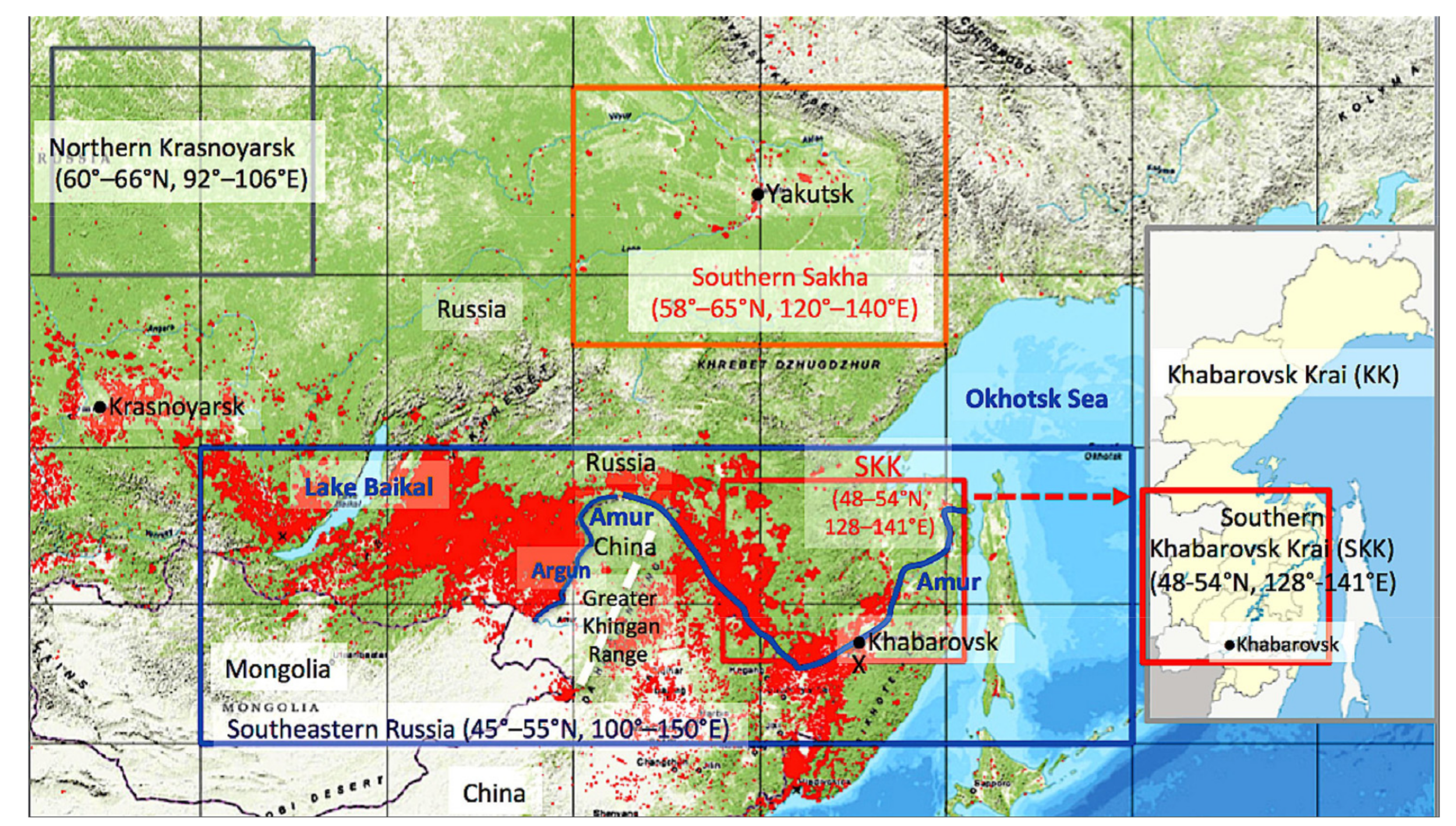
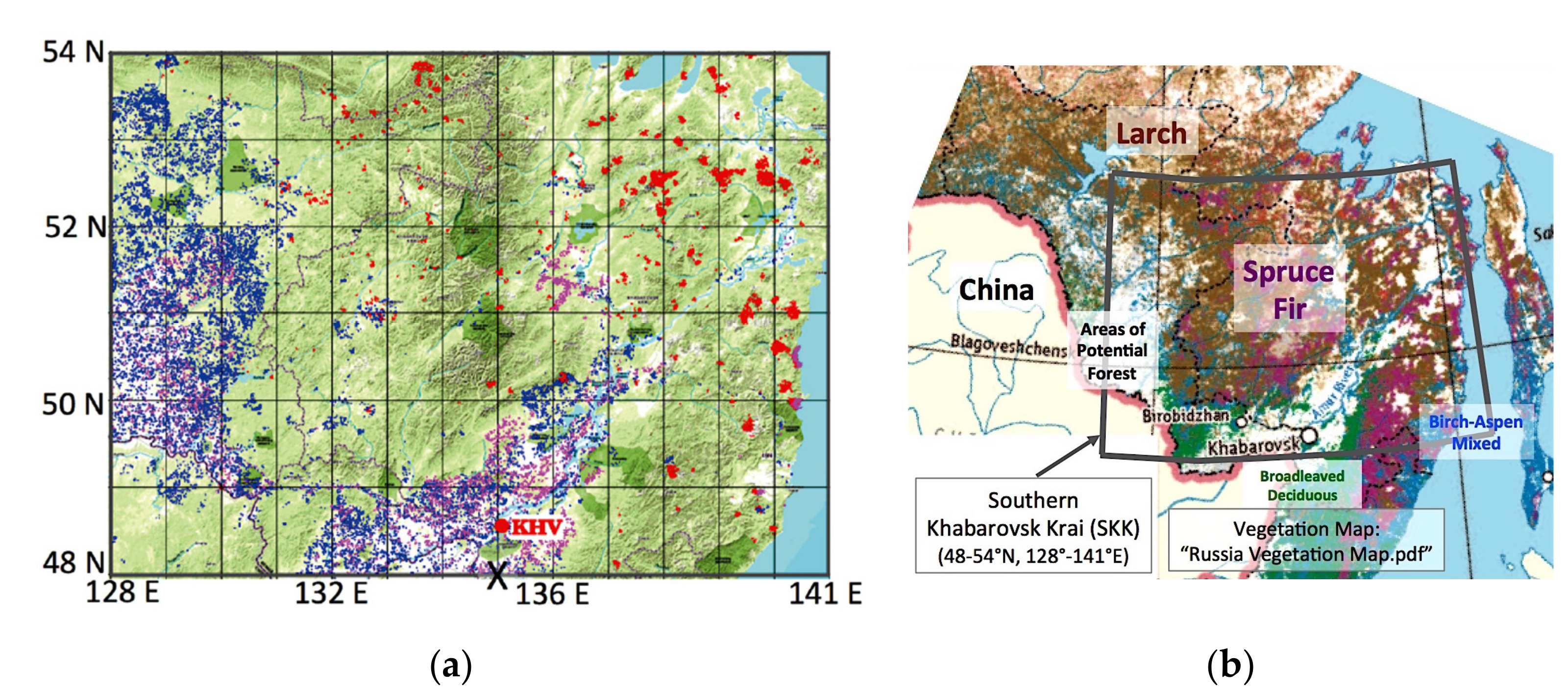
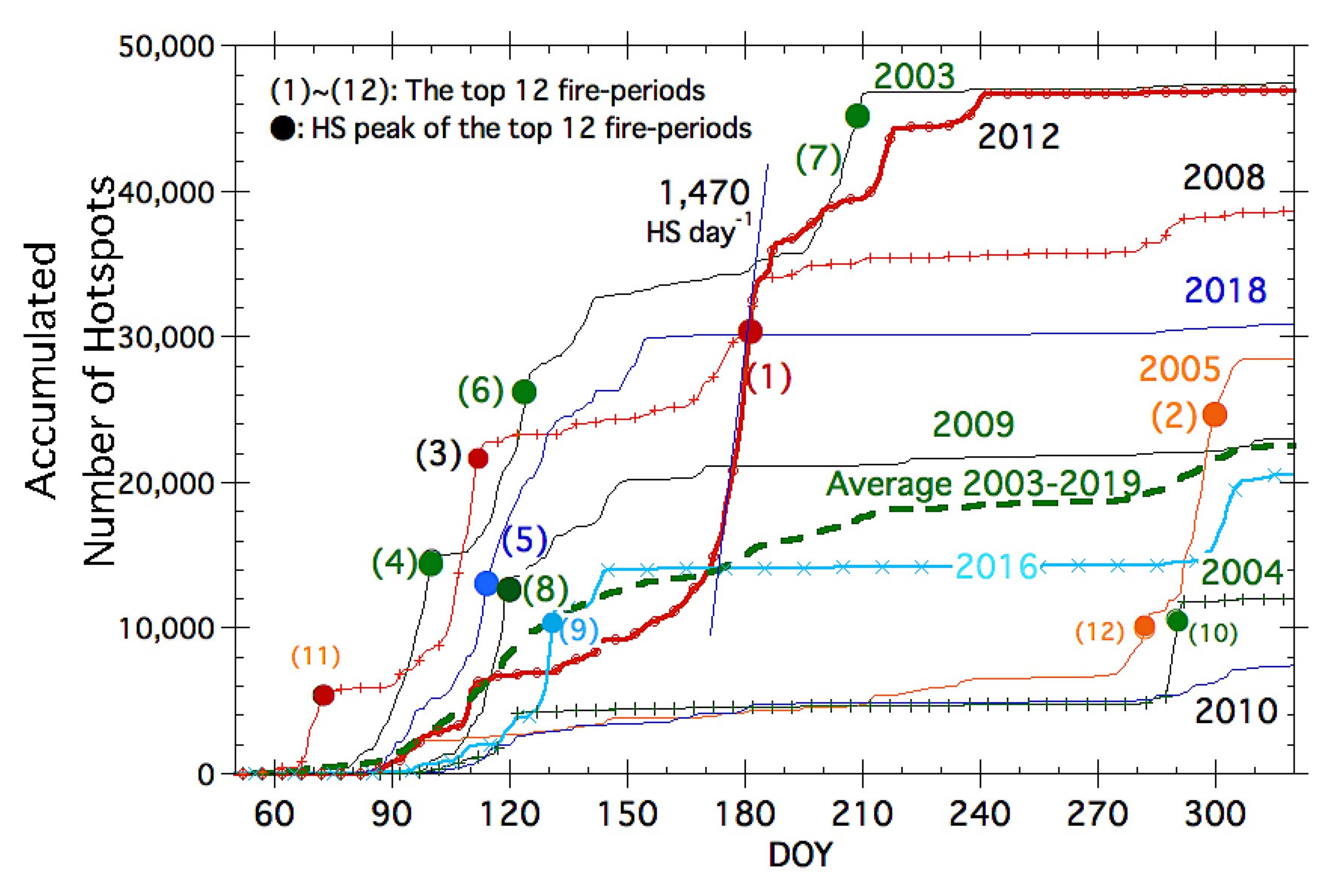
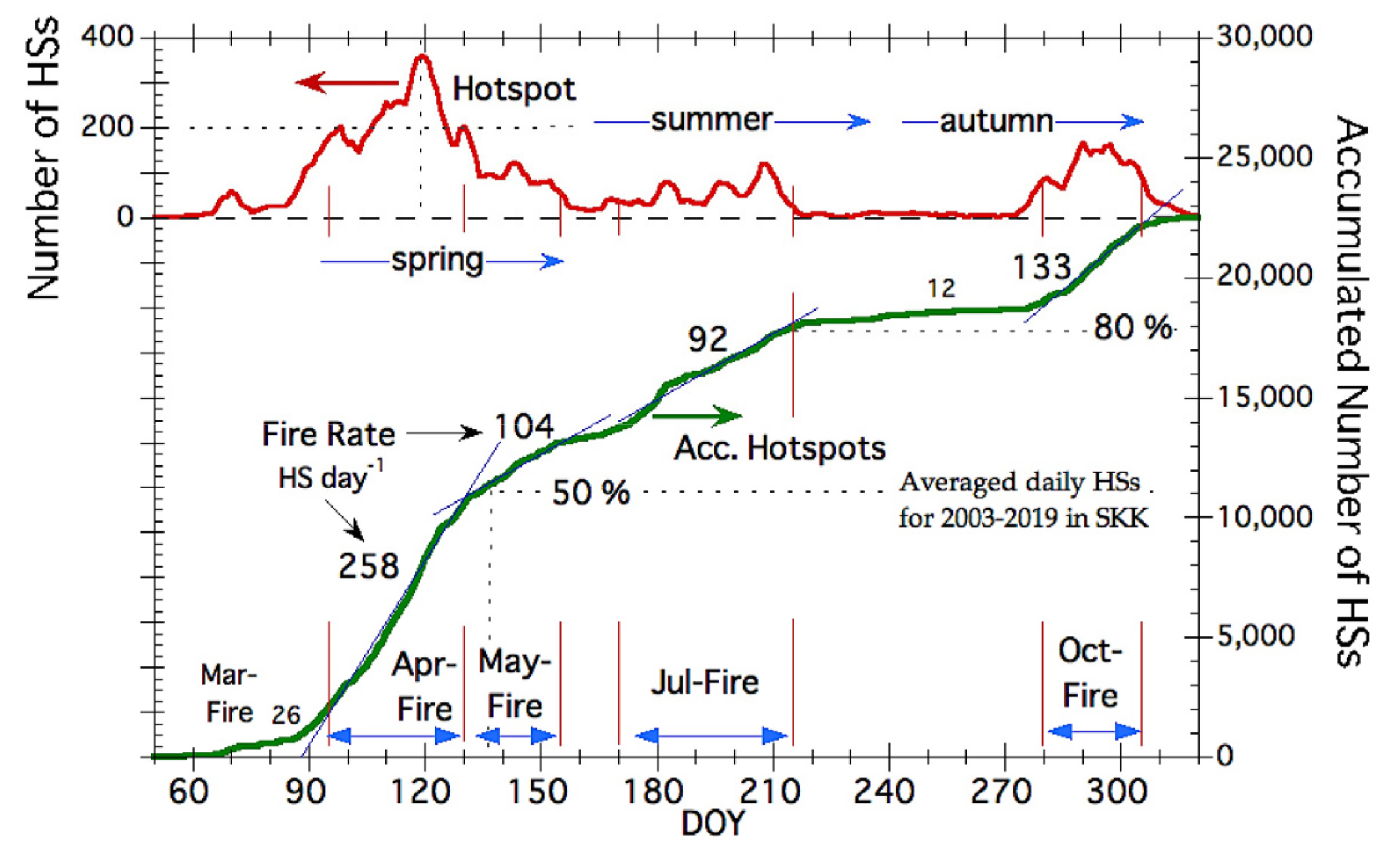
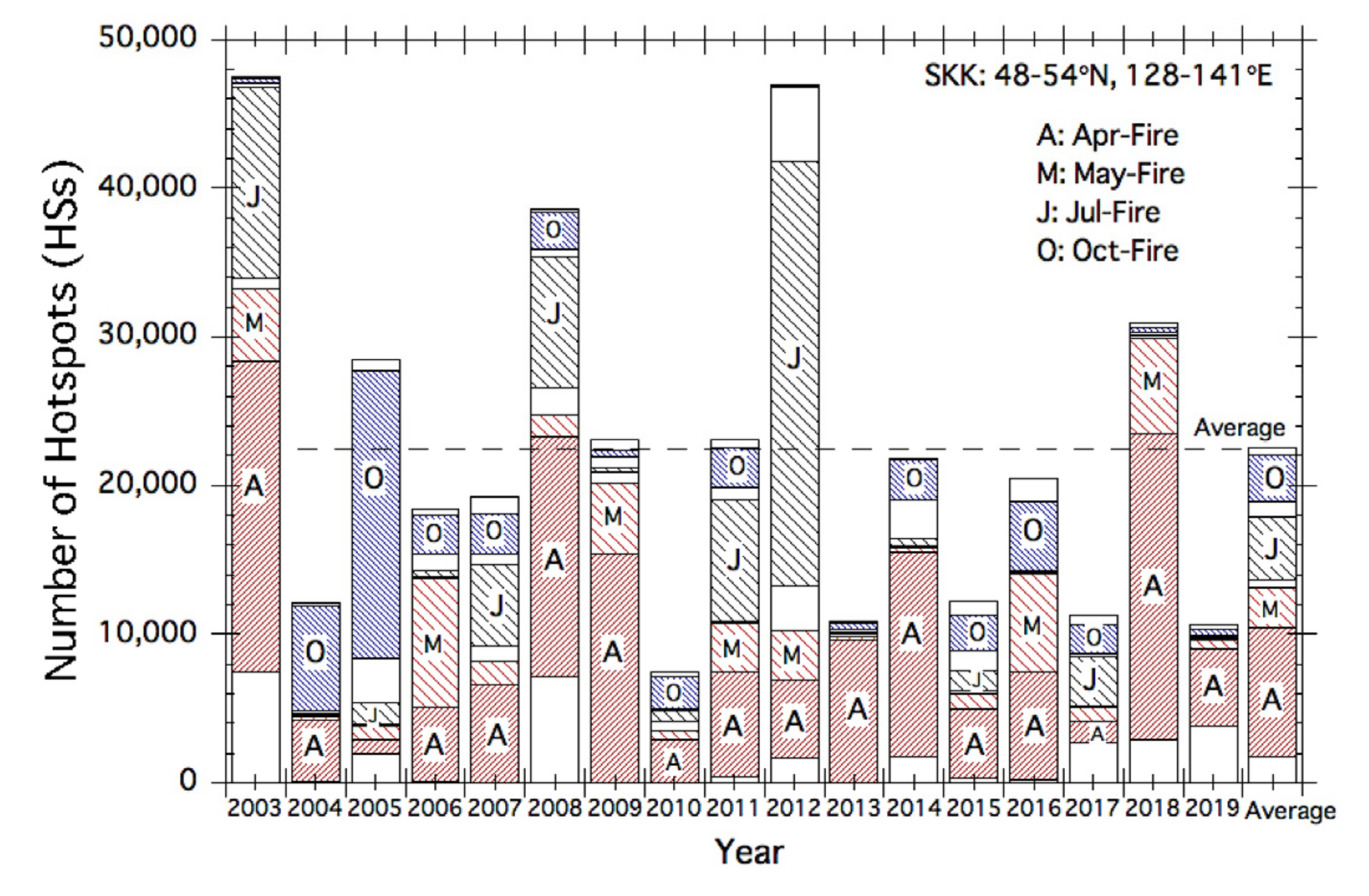
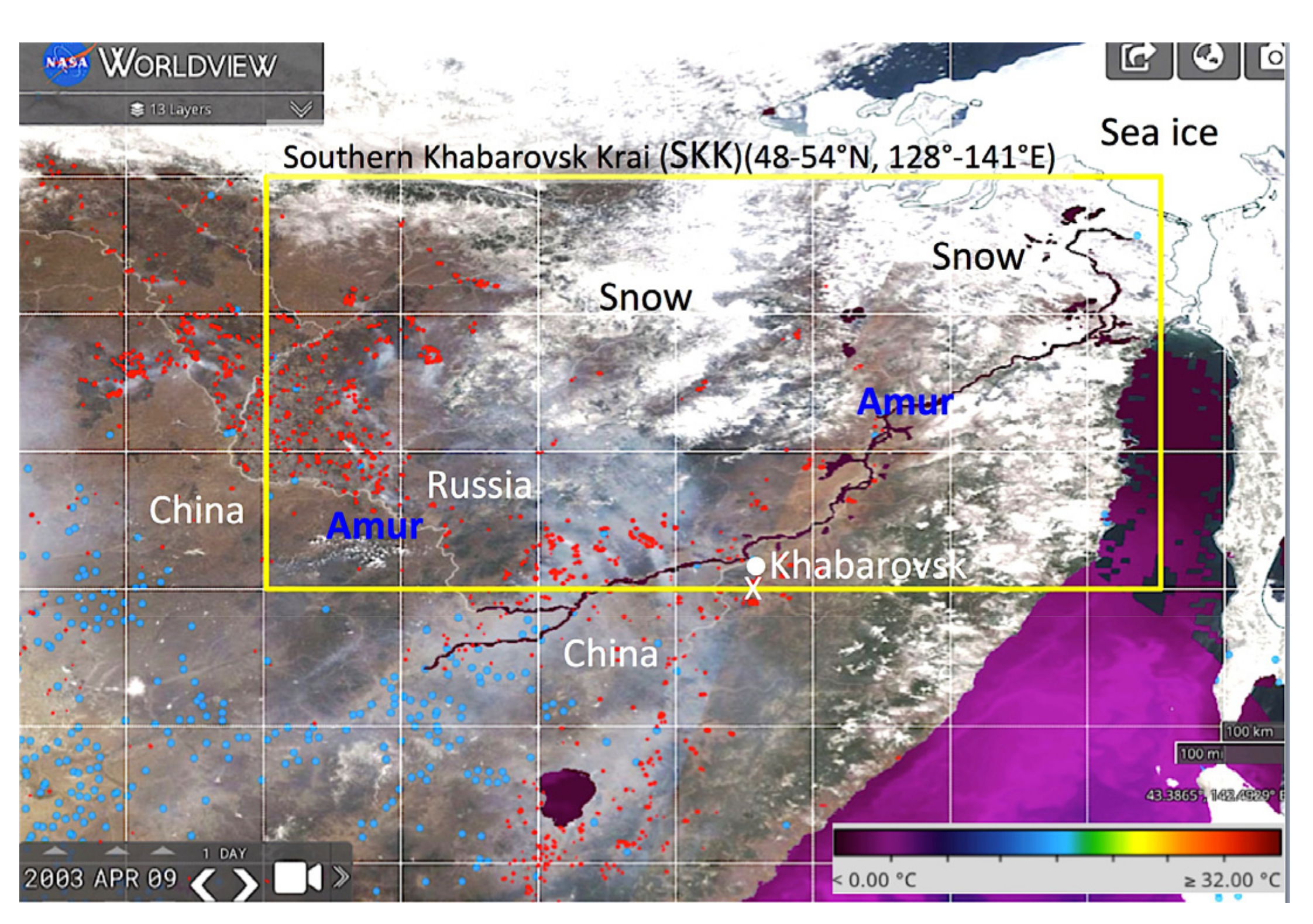
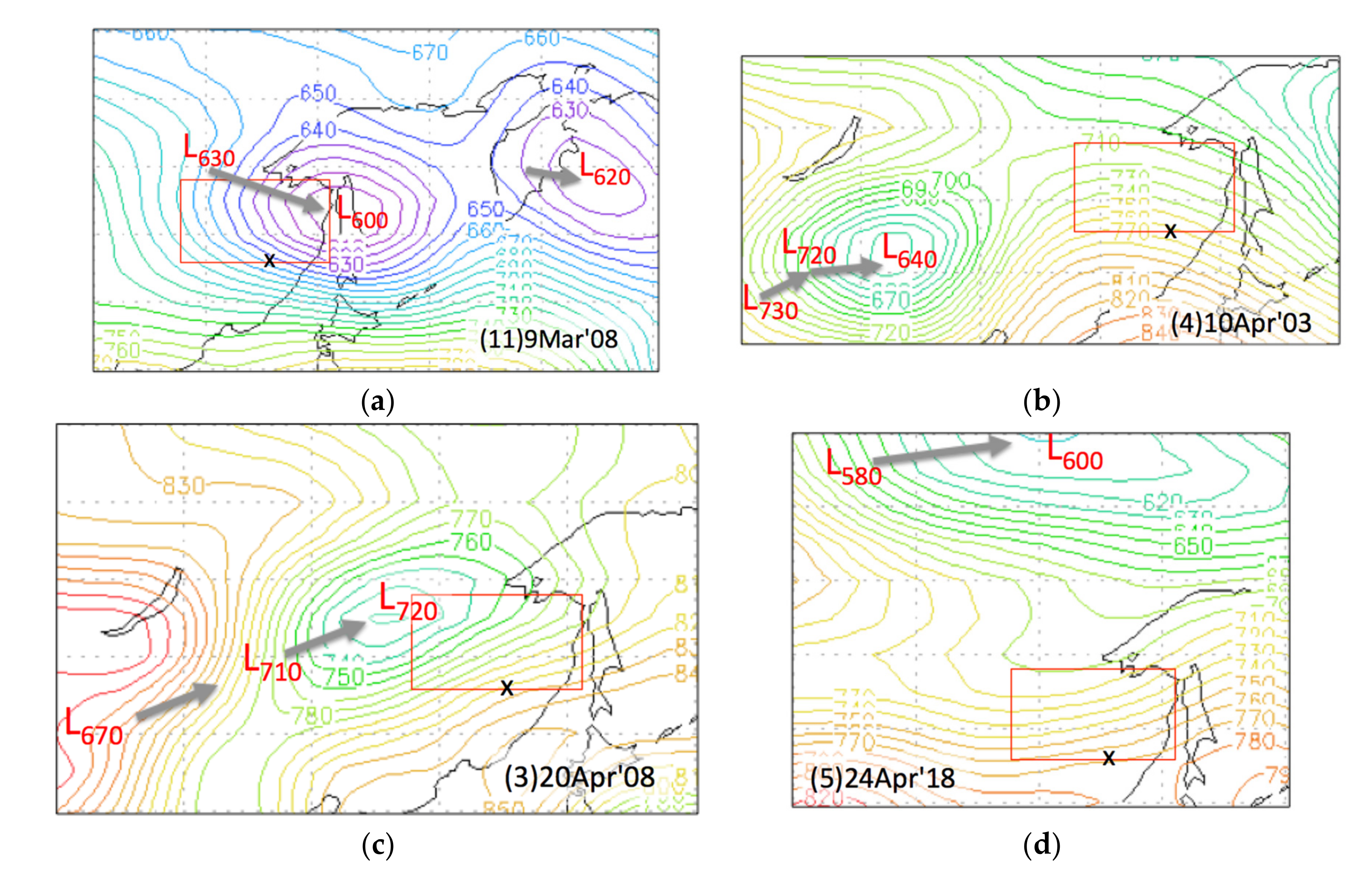
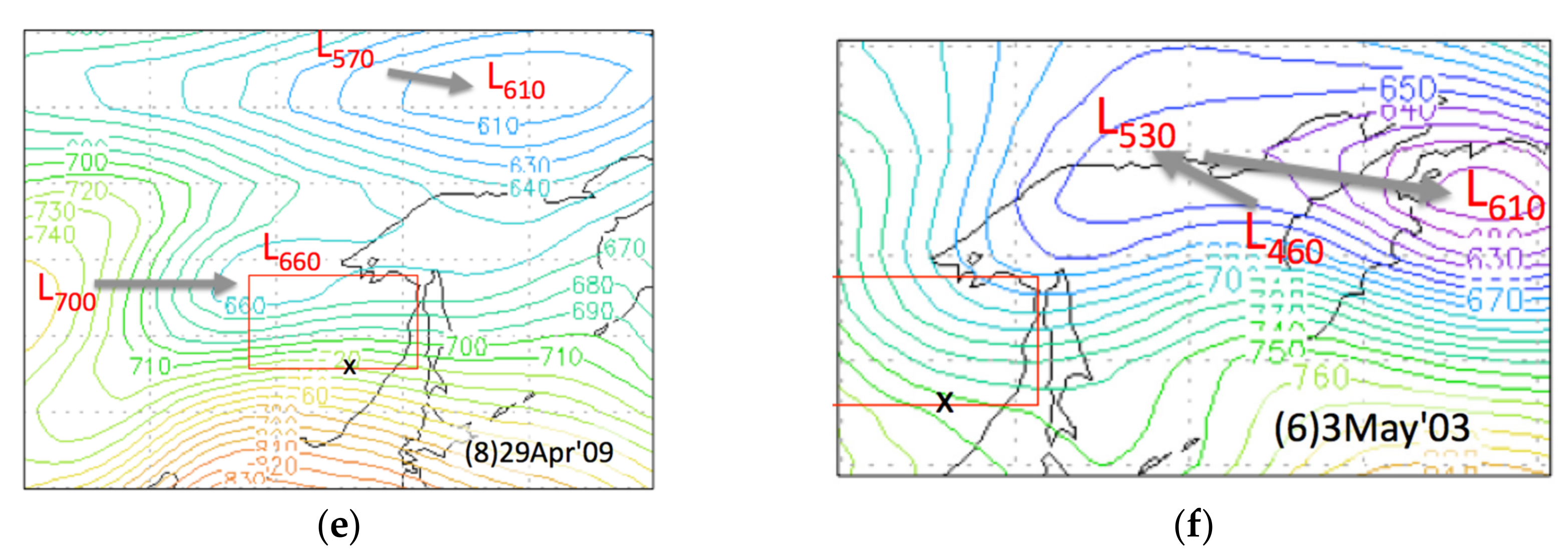


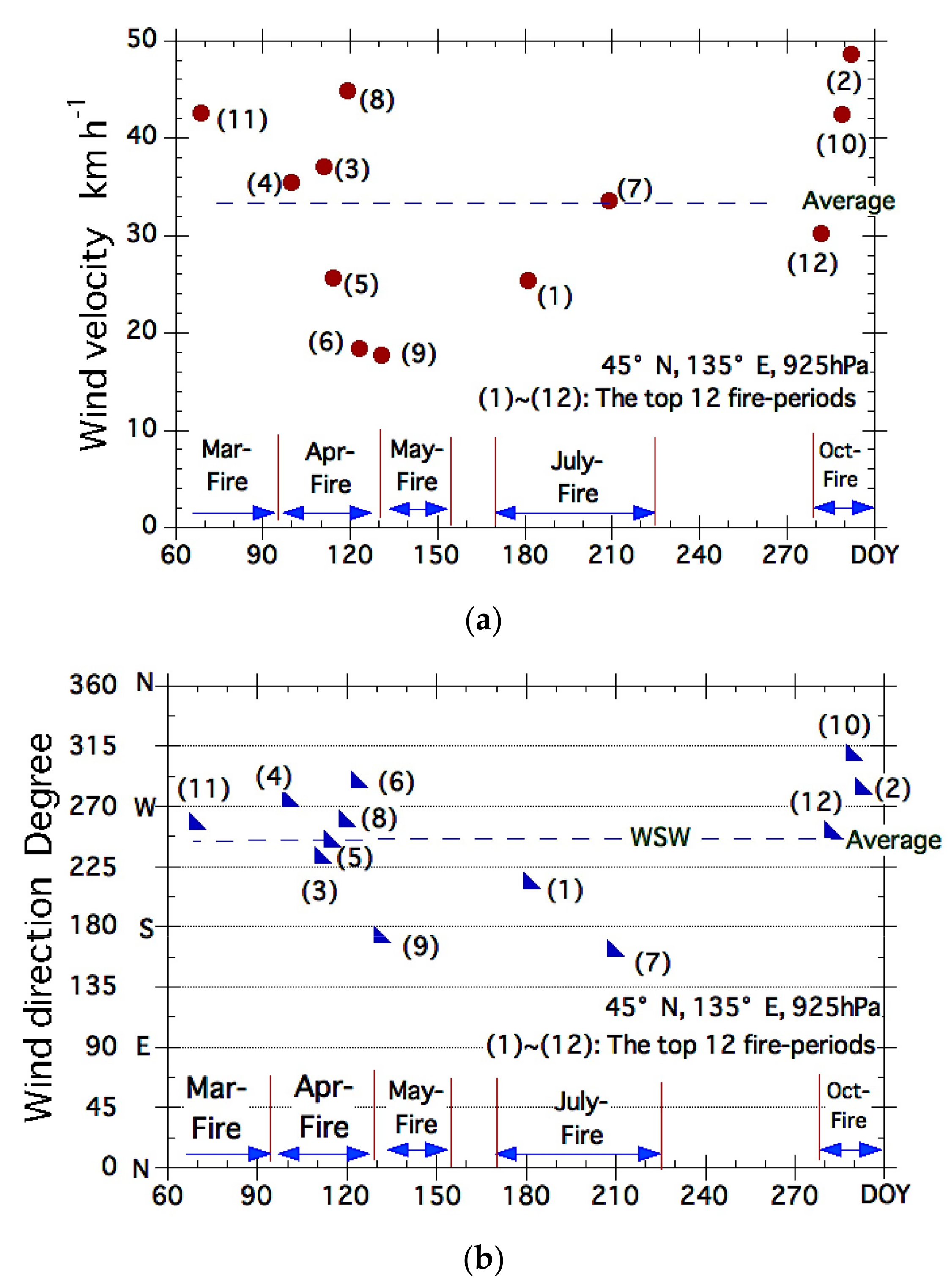
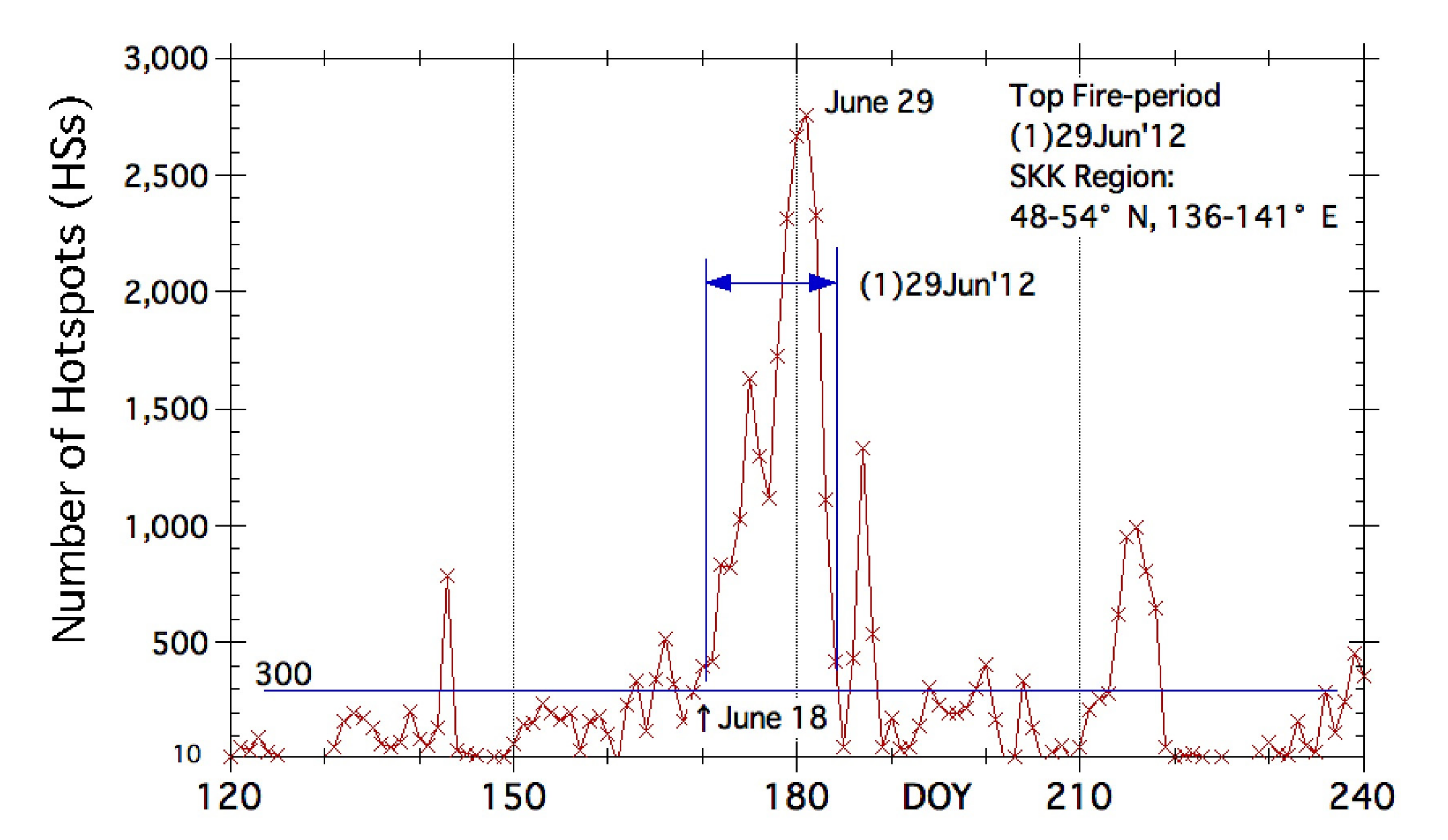
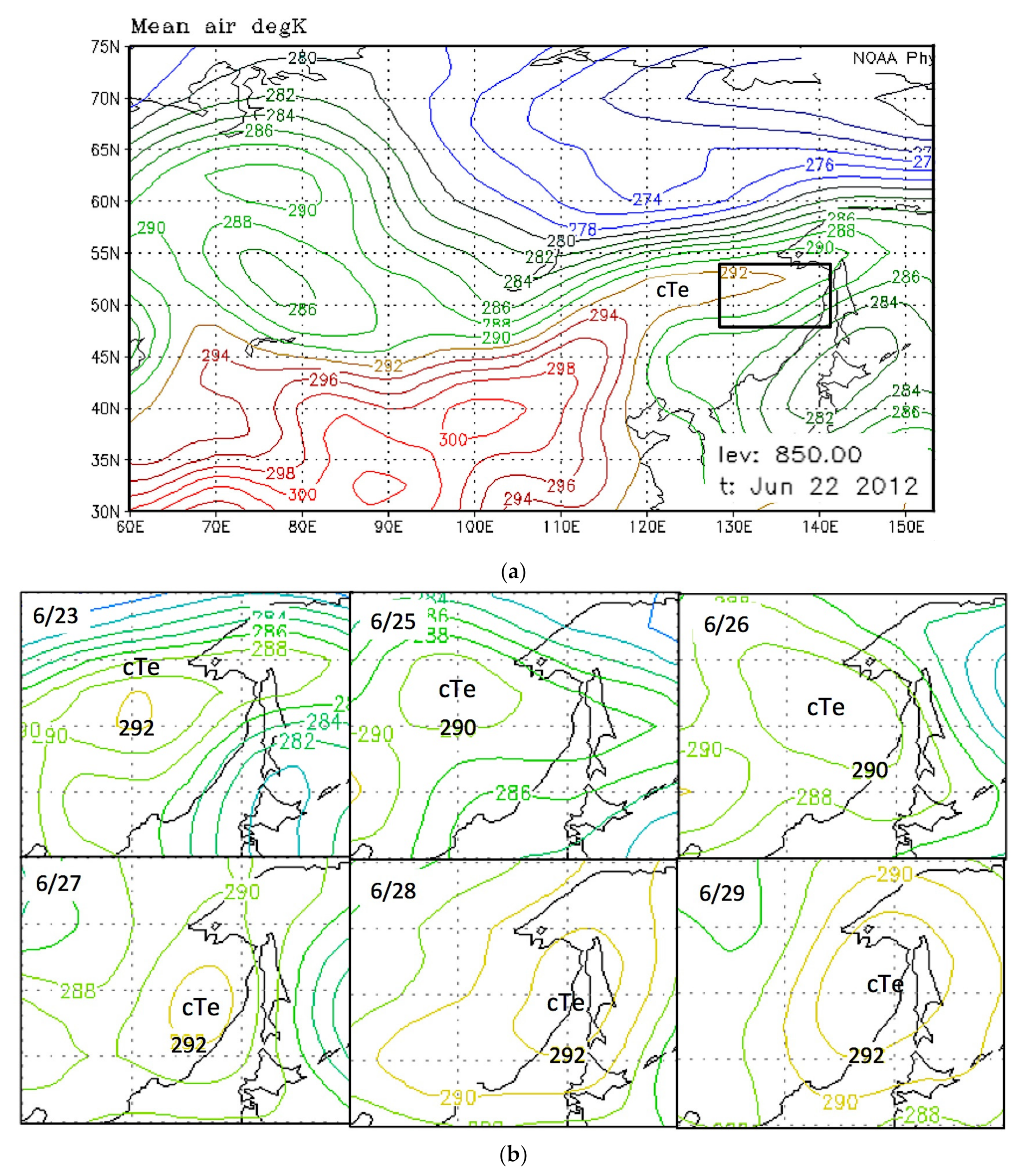
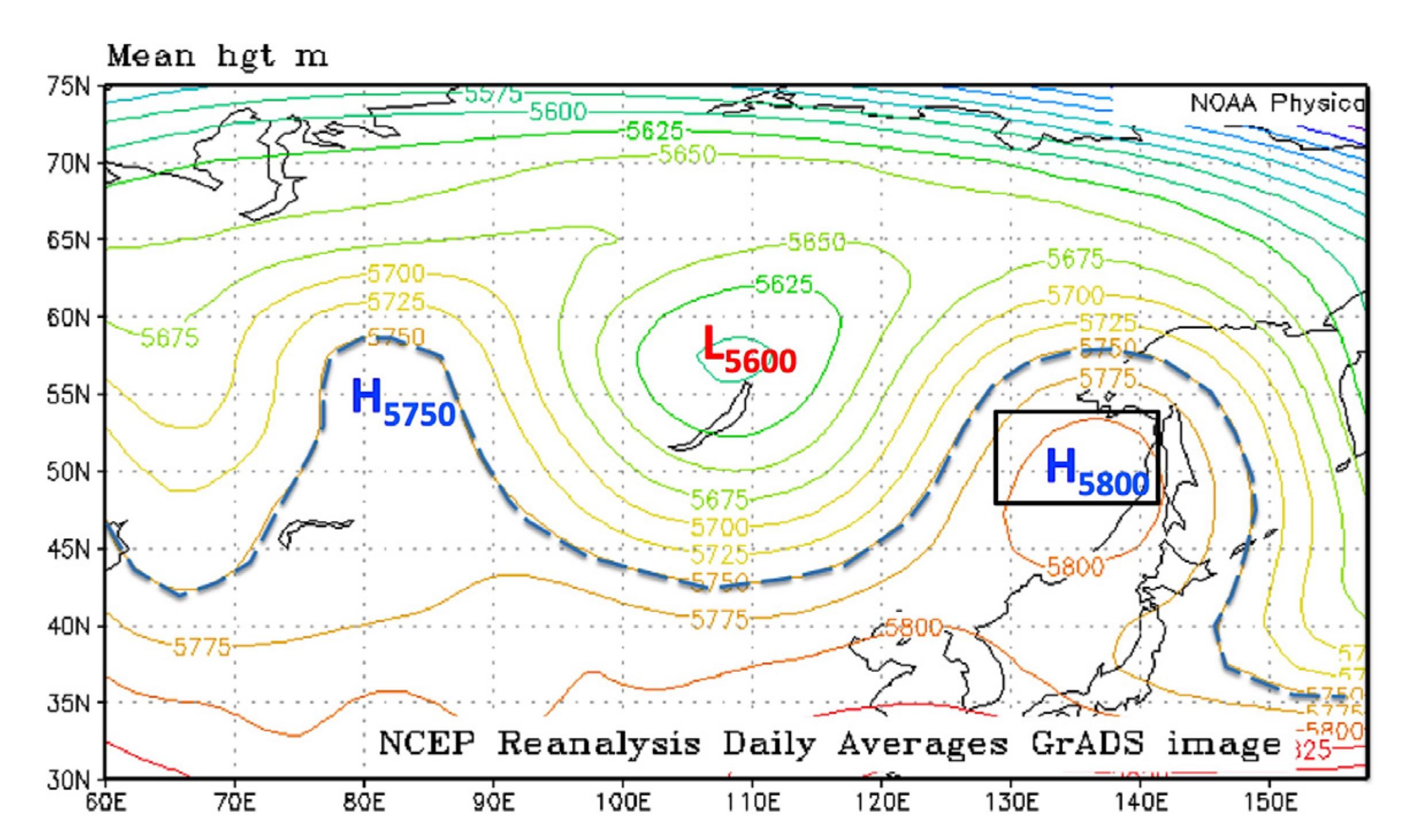
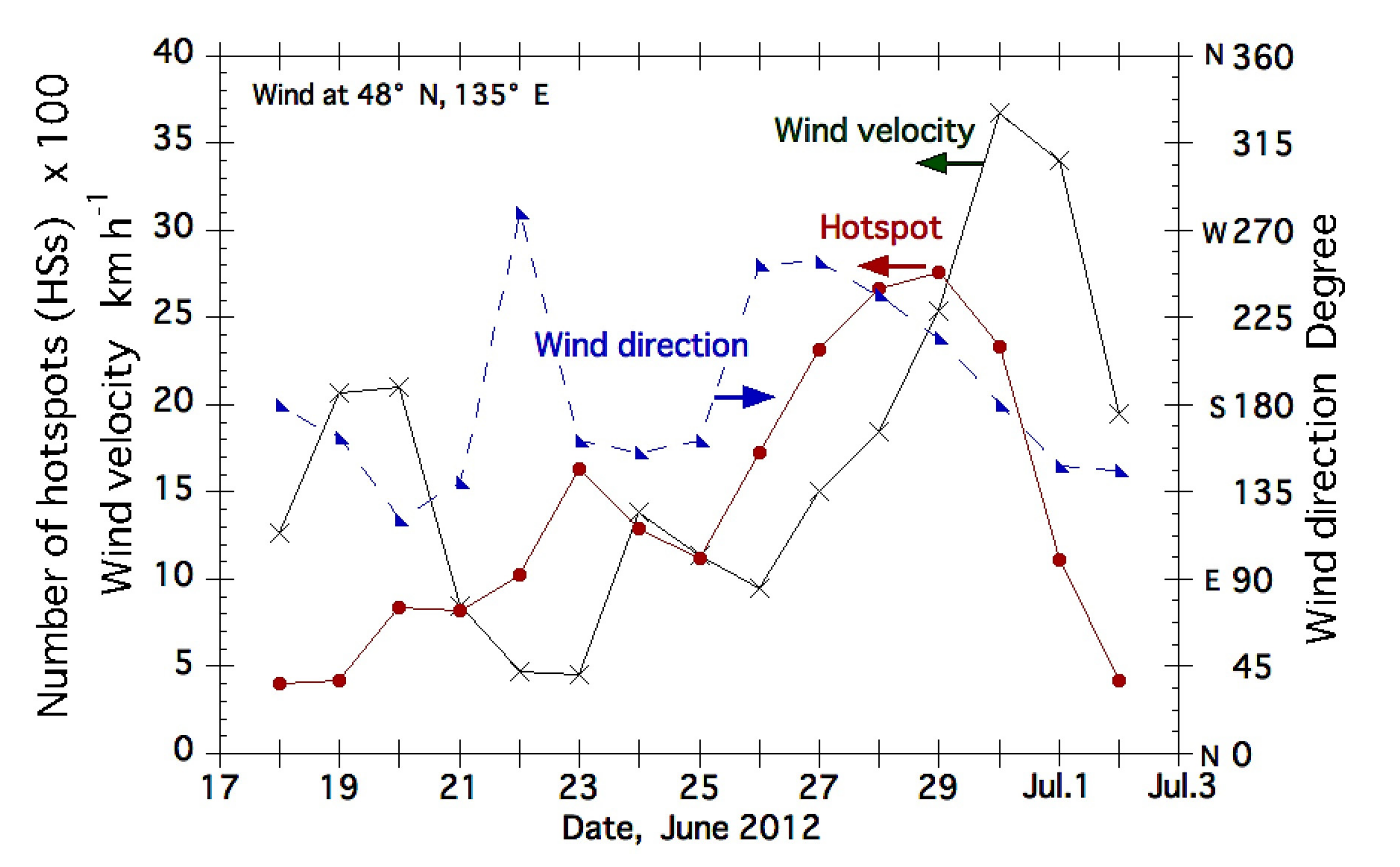
| Rank | Name | Year | Days | Total HS | Ratio to Total HS for 17 Years1 % | Factor for σ2 |
|---|---|---|---|---|---|---|
| 1 | (1)29Jun′12 | 2012 | 15 | 20,850 | 5.4 | 2.03 |
| 2 | (2)19Oct′05 | 2005 | 15 | 16,025 | 4.2 | 1.05 |
| 3 | (3)20Apr′08 | 2008 | 11 | 13,745 | 3.6 | 0.58 |
| 4 | (4)10Apr′03 | 2003 | 15 | 13,262 | 3.5 | 0.48 |
| 5 | (5)24Apr′18 | 2018 | 15 | 12,230 | 3.2 | 0.27 |
| 6 | (6)3May′03 | 2003 | 15 | 11,981 | 3.1 | 0.22 |
| 7 | (7)28Jul′03 | 2003 | 14 | 10,600 | 2.8 | −0.06 |
| 8 | (8)29Apr′09 | 2009 | 10 | 10,009 | 2.6 | −0.18 |
| 9 | (9)10May′16 | 2016 | 5 | 7,059 | 1.8 | −0.79 |
| 10 | (10)15Oct′04 | 2004 | 4 | 6,342 | 1.7 | −0.94 |
| 11 | (11)9Mar′08 | 2008 | 5 | 4,729 | 1.2 | −1.27 |
| 12 | (12)9Oct′05 | 2005 | 8 | 4,116 | 1.1 | −1.39 |
| Total | 132 | 130,948 | 34.2 |
© 2020 by the authors. Licensee MDPI, Basel, Switzerland. This article is an open access article distributed under the terms and conditions of the Creative Commons Attribution (CC BY) license (http://creativecommons.org/licenses/by/4.0/).
Share and Cite
Hayasaka, H.; Sokolova, G.V.; Ostroukhov, A.; Naito, D. Classification of Active Fires and Weather Conditions in the Lower Amur River Basin. Remote Sens. 2020, 12, 3204. https://doi.org/10.3390/rs12193204
Hayasaka H, Sokolova GV, Ostroukhov A, Naito D. Classification of Active Fires and Weather Conditions in the Lower Amur River Basin. Remote Sensing. 2020; 12(19):3204. https://doi.org/10.3390/rs12193204
Chicago/Turabian StyleHayasaka, Hiroshi, Galina V. Sokolova, Andrey Ostroukhov, and Daisuke Naito. 2020. "Classification of Active Fires and Weather Conditions in the Lower Amur River Basin" Remote Sensing 12, no. 19: 3204. https://doi.org/10.3390/rs12193204
APA StyleHayasaka, H., Sokolova, G. V., Ostroukhov, A., & Naito, D. (2020). Classification of Active Fires and Weather Conditions in the Lower Amur River Basin. Remote Sensing, 12(19), 3204. https://doi.org/10.3390/rs12193204







